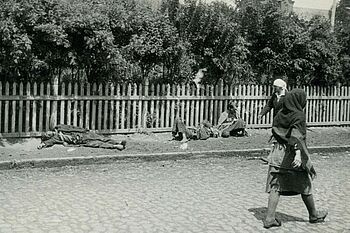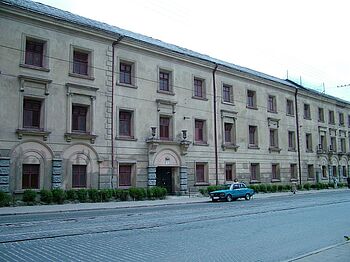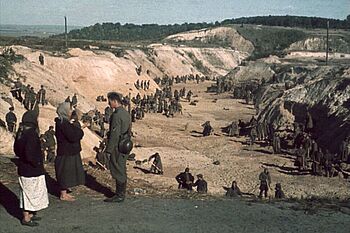Starvation, deportations, mass shootings – historian Timothy Snyder was right to classify the region of today's Ukraine as a “bloodland,” where an exceptionally large number of people were killed in the 1930s and 1940s. For decades, it was not possible to thoroughly investigate the crimes. Only recently has it been possible to secure many of the eyewitness accounts.
“Everyone just expects death”

Credit: Alexander Wienerberger, Public domain
Starving people lying on a sidewalk in Kharkiv. This photo and about 100 others were smuggled abroad by the Austrian chemical engineer Alexander Wienerberger in 1933. They represent some of the few images of the famine in Ukraine. Around the same time, Maria Zuk was allowed to leave the Soviet Union to join her husband in Canada. The farmer from an area near Odessa gave an interview to a Ukrainian émigré newspaper in Winnipeg. It is one of the earliest accounts of the Holodomor.
Q: When did you leave home?
A: On August 5.
Q: How were people living in Ukraine at that time?
A: There was a terrible famine. People were dying of hunger like flies.
Q: Did many die of hunger?
A: As far as I could learn, 25 versts [ca. 17 miles] in either direction about one-quarter of the population survived. Three-quarters died.
Q: Are people suffering the famine quietly, or are they rebelling?
A: How are they to rebel, and what will they achieve by rebelling? They suffer because they have lost all hope. They walk like the blind, and they fall wherever death strikes them. No one pays attention to the corpses lying on the streets. People either step over or 3 sidestep them and keep on walking. From time to time they are collected and buried in common pits. Seventy and more people are buried together.
Q: Have you heard anything about instances of cannibalism?
A: Why not? It happens all the time. There have been cases of a mother starving with her children and then killing and eating them when she sees that they are about to die. Or you are walking along the street and you see a corpse. You look around to see whether anyone is watching, and you cut off a piece of flesh and then bake or cook it.
Q: What is the reason for the famine? Has there been a drought or a bad harvest, or are you not sowing anything?
A: There has been a harvest, we sow and we plant, but as soon as anything grows, they take it all away and pack it off to Moscow. We had a good harvest this summer, but so what? They sent in the machines, cut everything, threshed it, and left not a kernel behind. They took everything. People were weeping. They asked, “What will we eat?” But the Chekists [members of the secret police] laughed and answered: “You’ll find something.” What will people not do in order to hide some grain for themselves! They hide it in their hair, they hide it in their mouth, beneath their tongue, but they [the Chekists] search it out and take it too.
Q: Do people on the collective farms live better?
A: At first they had it better, but now they take everything from them as well. I myself was on a collective farm, and if I have not died so far and could leave, it is only because my husband in Canada sent me money, and I could buy things in the Torgsin shops [state-run hard-currency stores].
Q: Do people not expect something better in the future?
A: They used to, but now things get worse and worse with every year. And now they have reached the limit. No one expects anything any more; everyone just expects death. Even the officials do not know what the future holds and only shrug their shoulders. Some tell the people, “Rebel, and we will join you.” And the people respond: “You rebel first.”
Q: How did you come to Canada? Through Romania?
A: No, that is impossible. You have to go through Moscow.
Q: And how do people live in Moscow? In the Moscow region? Is there also a famine there?
A: No, there is no famine there. There is enough of everything. When I arrived in Moscow, I could buy everything I wanted at the bazaar—bread and meat and vegetables.
Q: And how much did your passport to Canada cost?
A: 283 dollars.
Q: Rubles or dollars?
A: No, dollars, American dollars. My husband had to send them from Canada. If someone wanted to earn them, it could never be done. See these slippers on my feet? They cost me 90 rubles last year. I had to work three months in order to buy them.
Q: They take your wheat and grain, and you have no bread, but may you keep your animals? Cows, horses, chickens, pigs?
A: The famished people ate everything. If anyone still has a horse or cow, they guard it like the greatest treasure. People caught field mice and ate them like the greatest delicacies. The cats and dogs have been eaten long ago. Some collective farms still have pigs, but the Chekists guard them and seize and take them away as soon as they grow fat. People have already forgotten how pork tastes…
To read the entire interview, click here (English, p. 3f.).
Links
Testimonies by survivors of the Holodomor
Website with eyewitness accounts of the Holodomor
Website with photographic collections on the Holodomor
Digital collections of the Holodomor Research and Education Center
After the Dictatorship. Instruments of Transitional Justice in Former Authoritarian Systems – An International Comparison
A project at the Department of Modern History at the University of Würzburg
Twitter: @afterdictatorship
Instagram: After the dictatorship
With financial support from the German Federal Ministry for Economic Cooperation and Development
“There were four rows of corpses of murdered prisoners”

Credit: Stanisław Kosiedowski / CC BY-SA 3.0
Brygidki Prison in Lviv: In 1941, the former convent became the scene of a mass murder. After the Red Army invaded eastern Poland in 1939, the Soviet secret police took over the baroque cell block. Two years later, they murdered some 7,000 prisoners here and in two other prisons in the city before fleeing the Wehrmacht. Executions continued to take place here later. A report by a survivor of the Soviet massacre appeared in a Ukrainian exile newspaper in 1960.
"On the Sunday [29th june 1941], I learnt from Dr. Kashubynsky that the prisons were full of corpses of prisoners who had been murdered, and that this was, above all, the case as far as Lontsky prison was concerned. At dawn on the Monday, June 30, 1941, I noticed a German patrol on the street, through my window. Early that same morning I went to Lontsky prison, but the stench of rotting corpses was so dreadful that it was impossible to enter the prison.
I then walked on in the direction of Zamarstyniv prison, and on the way there I met a woman who had been in the same cell with me in Zamarstyniv prison; she told me that she had learnt from another prisoner that my brother had been murdered in Zamarstyniv prison. As I had already known during my imprisonment that my brother was also confined in the same prison, I now went there to search for his body. When I got there, I found a large crowd standing outside. German sentries were posted in front of the prison and they were letting people in, either separately or in small groups. When I told them that I had come to look for the body of my brother who had been murdered, they allowed me to go straight in.
I then witnessed the following scene: there were four rows of corpses of murdered prisoners. I counted 40 corpses, including 13 female ones. From their clothes, I recognized the bodies of three women with whom I had shared the same cell, but their faces were no longer recognizable. One of the women was called Iryna Shust and came from Brody; the other woman was from Lemberg [Lwiw], and the third was a Polish woman, whose Christian name was Marysia. One could see from the corpses that some of their bones had been broken. I failed to find my brother’s body amongst the male corpses, and, in any case, I did not know what clothes he had been wearing whilst in prison. I then asked whether there were any more corpses and was told that there were, but that they could not be viewed as they were no longer recognizable, since they were already in an advanced stage of putrefaction.
A few days later, I met a Jewess and a Polish woman on the street, with whom I had also shared a cell, and they told me that most of the executions in Zamarstyniv prison had taken place on Thursday, June 26, 1941. The two women had been taken into the cellar to be shot and on the way there had met my brother, who was likewise being taken there to be shot and who had enquired after me. The women said that the prisoners were shot in the neck from behind when they reached the entrance to the cellar. They had escaped death by dropping down at the cellar entrance; they had then lain hidden amongst the corpses of those who had been murdered until all was quiet again and they had been able to leave the prison. I am prepared to swear to the truth of my testimony on oath before a court."
To read the entire report, click here (English, p. 288ff).
“We went to our certain death”

Credit: Johannes Hähle / Public domain
This scene, captured by photographer Johannes Hähle on the edge of the Babi Yar ravine near Kiev in 1941, seems almost peaceful. In reality, prisoners are in the process of removing traces of one of the largest mass executions by the German occupation forces in Ukraine. More than 30,000 Jewish residents of Kiev were shot here on September 29-30, 1941. The 15-year-old Ruwim Schtein survived the massacre. Following the collapse of the Soviet Union, Ukrainian historian Boris Zabarko interviewed him and published this account.
My family, like all the Jews of the city of Kiev, set out. Before we left the house, I heard that all Jews were going to be shot. I told this to mama, but she didn’t want to hear it or couldn’t believe they could shoot so many innocent people, old people, children, women.
My family – mother, 38 years old, sister, 6 years old and me, 15 years old – believed in life, and we acted like all the Jews in town. We went to our certain death. With our old belongings, our documents and family photos, we literally merged into this endless stream of people marching toward death.
About 200 or 300 meters before the cemetery, the flow of people came to a halt. The brown shirts with the swastikas and the field gendarmerie formed columns and led the people in groups around a street corner, then around the next until they were behind the cemetery. Those waiting could not see anything. The Jews who arrived at this end point were mercilessly humiliated one by one: First, their documents, clothes and valuables were taken from them. The passports, documents and photographs were immediately thrown into the fire. The women’s clothes were torn off and thrown on a huge pile. The naked women, children and elderly were herded into closed cars and taken to Babi Yar.
It is impossible to describe what transpired at this site. Hysteria and terror, crying and desperation, mothers begging for mercy for their children. Many lost consciousness.
This is where I got separated from my mom and sister forever. They were taken away in gassing wagons2 and I was grabbed by the collar and put in the line where the men, young and the old who could still walk, were standing. They assembled groups of 100 to 150 people and led them in columns, on foot, guarded by soldiers, to Babi Yar where they would be shot.
As soon as we took the first steps, I began looking for a way to escape from the column. But how and in what way? The column was led by Hitler’s armed men and we were only 250 or 300 meters from Babi Yar (one could already hear shouting and shooting). I discreetly jumped out of the column into the ditch, crawled into a water drainage pipe under the road and sat there until nightfall. When the columns began passing less frequently, I climbed out on the other side of the road and walked across the old cemetery and through the vegetable gardens to the edge of town. That night I made my way back to our home. For a whole week I sat in the apartment without going out, and only when I heard someone trying to open the door from the outside, did I climb down the rain gutter from the second-floor balcony and run away.
To read the entire report by Ruwim Schtein, click here (pp. 17-26) (German).
1) Following the original, the place names have been transcribed here from Russian and not from Ukrainian.
2) According to scientific research, gassing vans – referred to as gas vans in Nazi jargon – were not yet in use at the time of the mass execution in Babi Yar.
Links
Excerpts from the experience report by Leon Weliczker Wells
Video interview with Babi Yar eyewitness David Ayzenberg
Video interview with Babi Yar eyewitness Mirgazim Sabirov
US-American Professor of History Victoria Khiterer on the Tragedy of Kiev's Jews
Final report on the so-called final solution to the Jewish question in Galicia (German)
Trilateral research project “Violence against Civilians on the Eastern Front“